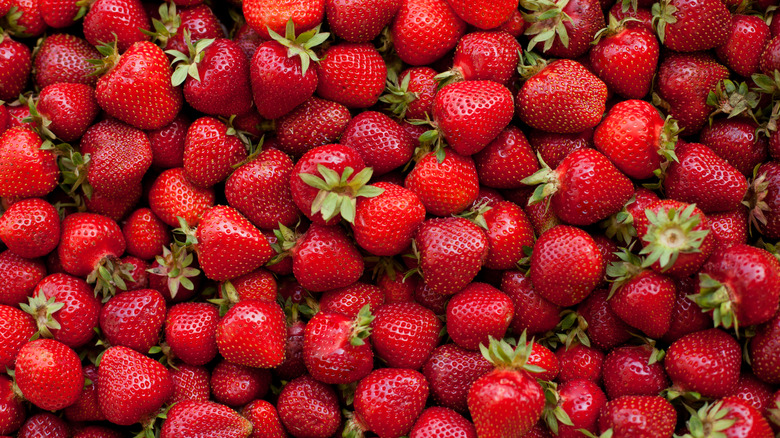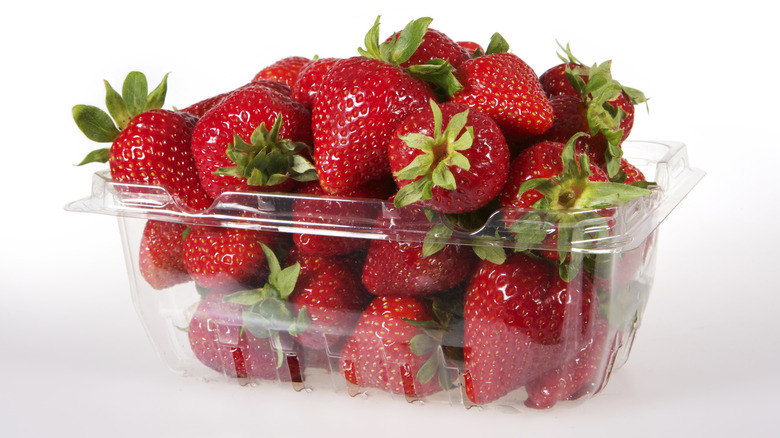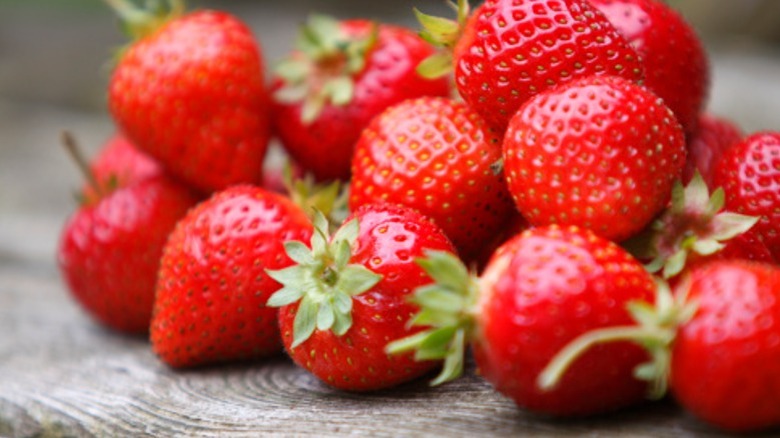The Trick To Buying The Freshest Strawberries Every Time
Anyone who's big into fruit can tell you that summer is the best season to get your hands on some strawberries. That's the time when you'll usually find cartons full of plump, juicy strawberries lining the shelves of your local grocer's produce aisle — far different than the meager selection of strawberries you'd find during the fall and winter seasons. Nothing says summer like biting into a fresh, perfectly ripe strawberry.
But not all strawberries you're going to find at the grocery store are going to be fresh. Have you ever brought home a carton of strawberries and found that, instead of the stereotypical bright red berries, they're almost brown in color? Maybe they're smaller than what you expected and they have a surprisingly bland flavor. Maybe you bit into the plumpest-looking one and found it was more water than juice. These strawberries are better off in a compost heap than on any cake, pie, or salad that you're making. What went wrong?
Strawberries and other types of berries tend to go bad quickly thanks to the high content of moisture and water. Much like picking out any other type of produce at your local grocer, choosing the best carton of strawberries is a bit more involved than pulling a random package off the shelf. One good way to see if the berries you're buying are ripe is to check to see whether or not the fruit is sticking to the underside of the carton.
Check if your strawberries stick to the absorbing pad
When you buy strawberries, blueberries, and blackberries, you'll notice that there's a sheet of paper at the bottom of the carton. It looks like a paper towel just haphazardly shoved into the bottom, stained with juices and crushed bits of berries. This is known as an absorbent pad and, as the name implies, its purpose is to absorb any liquids that may leak out from the berries inside. While useful in keeping the carton from becoming a sticky mess, it's also good for telling you if the berries inside are ripe.
To do this, simply grab the carton of strawberries you're looking to buy and then turn it upside-down. As the strawberries shift around inside, take notice of how many strawberries stick to this absorbent pad. If none stick to the pad, then you'll be perfectly fine. If some do stick to the paper pad, then you're better off getting another carton.
But why would a few strawberries sticking to an absorbent pad change anything? If any berries stick to the pad, this is a good sign that a few of them have burst or been crushed during transport, causing their juices to leak out. These crushed berries, smeared in their own juices, are prime targets for mold due to the increased amount of moisture. While you could still buy them, you'll have to use them pretty much as soon as you get them or else they'll mold up quickly.
Look for unbroken, bright red strawberries
Even if there was no risk of mold involved, buying a carton of strawberries from your local grocer only to find most of them have been smashed into a sticky mess isn't something you'd consider to be good fortune on your part. Aside from seeing if any berries have been crushed, what else should you look for in your strawberries?
The keyword for strawberries is "vibrant." Look for any strawberries that have a bright, unblemished color to them– no spots, no stains, no discoloration. A good sign of fresh, ripe berries are strawberries that have a bright red color to their flesh and green leafy stems. If the caps are wilted or have dark brown spots, these strawberries may not be good for very long when compared to healthy green caps. You may also want to try and look for differences in shape and size, such as a slender strawberry compared to a stout round berry. While these differences don't always mean the strawberry you get will be more flavorful than another, it's good to focus on berries that have a healthy shape to them. You obviously wouldn't want a strawberry that's short, brown, and mushy, right?
So long as the strawberries you picked are bright, unblemished, and whole, you needn't worry too much about them spoiling too quickly. Keep in mind, however, that strawberries can still go bad if not used in a set time frame, so don't let them sit around.


